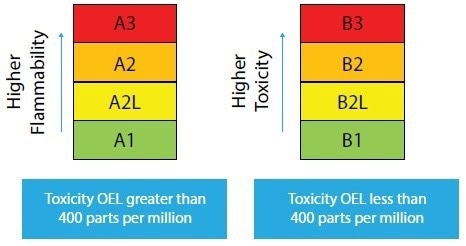Across nearly every industry, there has been an increased push for fuel and energy efficiency, as well as for a reduction in the impacts of global warming. Among these industries, the heating, ventilation, and air conditioning (HVAC) sector has been particularly focused on advancing this trend.
The U.S. Energy Information Administration reports that cooling residential and commercial buildings alone accounts for 10% of total electricity consumption.
In response to this, the HVAC industry is now advocating for A2L HVAC systems, which utilize new refrigerant types that are both energy-efficient and less detrimental to the environment.
The adoption of these advanced A2L refrigerants is poised to significantly contribute to the reduction of greenhouse gas emissions and promote a healthier planet.
Push for A2L - Regulatory and Historical Background
The groundwork for the development of A2L refrigerants dates back to the late 1970s and early to mid-1980s, when researchers investigating the thinning of the ozone layer in the Earth's atmosphere uncovered the detrimental effects of man-made chlorofluorocarbons (CFCs) and hydrochlorofluorocarbons (HCFCs) on the planet.

Image Credit: Sensata Technologies, Inc.
The findings eventually led to the establishment of the Montreal Protocol, which was adopted in September 1987 by the United Nations. It is the only treaty that has been endorsed by every country on the planet, including all 198 UN Member States.
The treaty introduced a phase-down schedule for nearly 100 synthetic chemicals classified as ozone-depleting substances, including many that were traditionally used in refrigeration and air conditioning.
Across nearly every industry worldwide, there has been a continued push for fuel and energy efficiency – along with a reduction in global warming impacts.
Introduced to replace those ozone-depleting chemicals, in many cases, were another group of substances called hydrofluorocarbons (HFCs). While HFCs did not harm the ozone layer, they still had a high global warming potential (GWP), making them a significant contributor to climate change.
To address this concern, the United Nations developed the Kigali Amendment in 2016, which aimed to phase out HFCs and reduce their use by 80 to 85 percent by the late 2040s in developed countries.
Many European countries have taken individual measures to address this issue, and the United States ratified the Kigali Agreement in September 2022.
The shift in refrigerant technology and strategy over the past four decades has emphasized the movement toward systems with a reduced GWP and a lower environmental impact.
Breaking Down Environmental Impact of Refrigerants
The focus on A2L refrigerants stems from the environmental impact of refrigerants, which is determined by their overall effect on the environment. The classification of chemicals in terms of flammability and toxicity, according to ISO 817, is a way to holistically assess their impact.
Chemicals in category A3 are highly flammable, whereas those in category B1 are toxic. A2L chemicals, on the other hand, are slightly flammable and less toxic.
Efficiency is also a critical factor in determining the ideal chemical for a given application. In the case of HVAC systems, 70 percent of their environmental impact comes from power consumption and the energy generation processes used to provide it.
Thus, it is crucial to strike a balance between a chemical’s global warming potential (GWP) and its efficiency in an HVAC environment while also considering safety concerns.
Legacy hydrofluorocarbons were highly efficient in HVAC systems, but they carried significant GWP rates and contributed to ozone depletion.
The A2L refrigerants that have been developed in recent years offer stronger HVAC performance without those negative side effects.
While alternative chemicals like propane, CO2, or ammonia have been explored for HVAC systems, each has faced significant obstacles that have hindered their widespread adoption.
For instance, CO2 systems operate at much higher pressures (5-10 times) than traditional HVAC systems, making them unsuitable for certain contexts. Propane, on the other hand, poses a serious fire hazard due to its high flammability, while ammonia can be highly toxic if not handled properly.

Image Credit: Sensata Technologies, Inc.
Table 1. Source: Sensata Technologies, Inc.
| |
R12 Freon
(Banned CFC) |
HFC-134a |
HFC-152a |
CO2
(R-744) |
Propane
(R290) |
Ammonia |
| Ozone Depletion Potential (ODP) |
1 |
0 |
0 |
0 |
0 |
0 |
| Global Warming Potential (GWP) |
10,200 |
1,430 |
124 |
1 |
3 |
0 |
| Flammability / Toxicity |
A1 |
A2L |
A2L |
A1 |
A3 |
B2L |
| Operating Pressure Range |
2.1 - 11.7 bar |
0.6 - 6.7 bar |
0.6 - 6.7 bar |
10 -150 bar |
10 - 50 bar |
2.9 -13.5 bar |
The A2L category represents an attempt to find the right balance between GWP, safety, and cooling efficiency, making it an ideal choice for HVAC systems.
Codifying A2L HVAC Systems in Buildings
A2Ls have already been utilized in various regions, including the European Union, Japan, India, Australia, and the automotive industry.
As the benefits of using A2L systems in commercial and residential HVAC systems became more apparent, regulatory organizations such as ASHRAE 15-2019 and UL 60335-2-40 have adjusted their guidelines to accommodate their use.
A2L gases require a certain level of concentration above their lower flammability limit and an ignition source to burn. Consequently, regulatory efforts have focused on preventing and detecting leaks in these systems to reduce the risk of ignition.
HVAC systems that use A2L refrigerants must be designed in such a way that they cannot operate if the leak detection system is bypassed.
These leak detection systems must function effectively under challenging environmental conditions, including extreme temperatures and high levels of condensation, without requiring frequent maintenance or calibration over their planned 15-year lifespan.
Certain chemicals used in servicing HVAC equipment may negatively affect some detection systems, adding pressure on HVAC Original Equipment Manufacturers (OEMs) and their partners to devise solutions for this new generation of equipment.
Looking Forward with Refrigerant Technology
For over 40 years, the HVAC industry has been driven by the pursuit of more eco-friendly refrigerants and technologies, and this trend is expected to continue well into the future.
The Kigali Amendment has set the stage for a reduction in the use of HFCs, which is anticipated to prevent the release of more than 100 million tons of carbon dioxide equivalent to greenhouse gases into the atmosphere.
This effort is projected to prevent a global temperature rise of up to 0.5 degree Celsius by the year 2100.
As the industry looks to the future, it will continue to advance its designs and technologies, guided by a commitment to environmental sustainability, safety, and energy efficiency on a global scale.

This information has been sourced, reviewed and adapted from materials provided by Sensata Technologies, Inc.
For more information on this source, please visit Sensata Technologies, Inc.